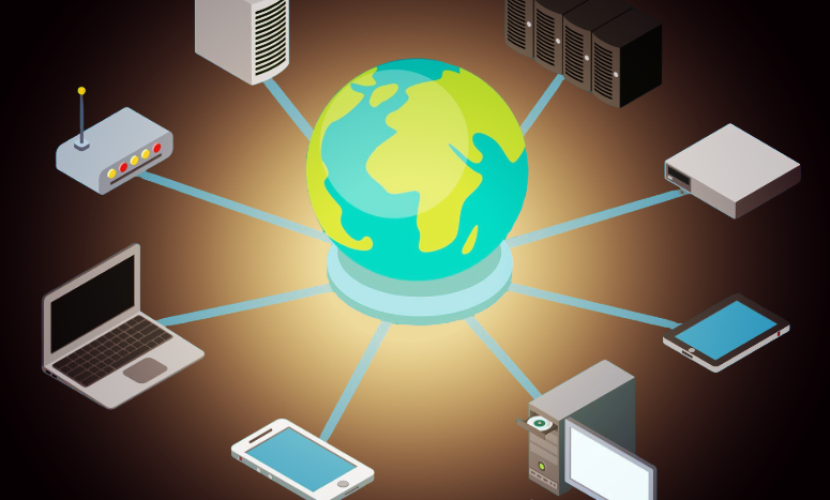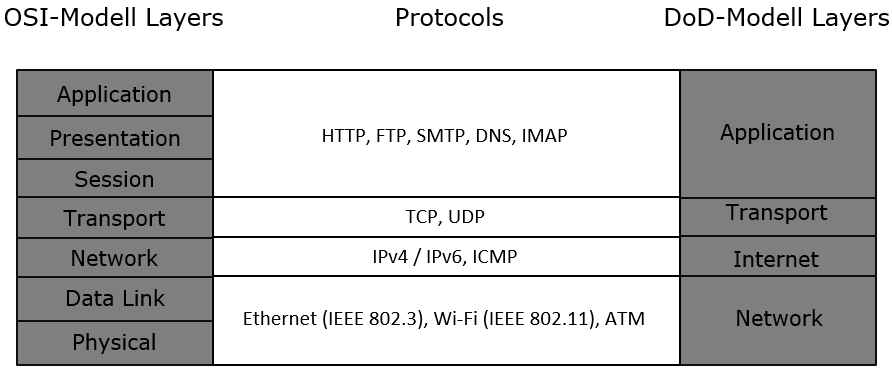TCP/IP: Introduction to Network Protocols and Communication

The two communication protocols TCP (Transmission Control Protocol) and IP (Internet Protocol) are responsible for the transmission and transport of data packets in a global, decentralized network. They form the global standard for communication over the internet and are indispensable in both local area networks (LAN) and wide area networks (WAN). Together, TCP/IP protocols enable reliable data transfer across diverse networks.
TCP/IP Protocols in the DoD and OSI Models

TCP and IP are essential components in both the DoD model (Department of Defense) and the OSI model (Open Systems Interconnection). These models help organize and standardize network communication processes.
TCP/IP in the DoD Model
In the DoD model (also called the TCP/IP model), these protocols are assigned specific layers:
- The Network Layer uses IP to route and address data packets.
- The Transport Layer relies on TCP to ensure reliable, error-free data transmission.
TCP/IP in the OSI Model
The OSI model, on the other hand, assigns these protocols to the following layers:
- The Network Layer (Layer 3) focuses on routing and addressing through IP.
- The Transport Layer (Layer 4) ensures data reliability and correct sequencing with TCP.
Tasks and Functions of TCP/IP
The main task of TCP is to ensure the reliable, error-free, and correctly ordered transmission of data between devices. On the other hand, IP handles addressing and routing of data packets to ensure they reach their destination across various networks. Below is an overview of the key tasks and functions of TCP/IP:
1. Data Packetization and Addressing
TCP/IP enables the division of data into small packets that are sent across the network. These packets contain information about their source, destination, and content. Addressing is done using IP addresses, which are uniquely assigned to each device on the network. This ensures correct delivery of the data to the target device.
- IP (Internet Protocol) handles addressing and route selection (routing) of data packets across the network.
- TCP (Transmission Control Protocol) ensures these packets arrive in the correct order and that no data is lost.
2. Connection Establishment and Data Transfer
TCP guarantees reliable data transfer by establishing a connection between the sending and receiving devices. This process follows the TCP three-way handshake:
- SYN (Synchronize): The client sends a SYN packet to start the connection process.
- SYN-ACK (Synchronize-Acknowledge): The server acknowledges by responding with a SYN-ACK packet.
- ACK (Acknowledge): The client confirms the reception of the SYN-ACK, and the connection is established.
Once the connection is active, TCP ensures data packets are delivered in the correct sequence and without errors. If any packet is lost during transmission, TCP requests the retransmission of that specific packet.
3. Error Detection and Error Correction
To maintain data integrity, TCP incorporates mechanisms for detecting and correcting errors. Each transmitted packet includes a checksum to verify its contents have not been altered during transmission. If an error is detected, TCP automatically requests a retransmission of the affected packet. This ensures that the transmitted data reaches the receiver intact.
4. Flow Control
Flow control ensures that the receiver is not overwhelmed with more data than it can process. TCP uses a method called the Sliding Window technique, where the receiver informs the sender of the maximum number of packets it can handle at once. This helps prevent network congestion and improves the efficiency of data transfer.
5. Congestion Control
To avoid network congestion, TCP employs various techniques that adjust the data transmission rate. When the network becomes overloaded, TCP automatically reduces the transmission speed to avoid sending too many packets simultaneously. Algorithms such as Slow Start, Congestion Avoidance, and Fast Retransmit are used to manage network congestion effectively.
6. Multiplexing
Multiplexing enables multiple applications to share a single TCP/IP connection. TCP uses port numbers to route data packets to the correct application or service on a device. This allows different applications, such as a web browser (via HTTP) and an email client (via SMTP), to operate simultaneously on the same device without interference.
7. Routing
IP is responsible for routing data packets across various networks. When a packet needs to be sent from one device to another located in a different network, IP determines the best possible path (or route) for the packet. Routing tables stored on routers guide this process, ensuring that data packets are efficiently routed through the network.
8. Security
While TCP/IP itself does not provide built-in encryption or authentication, security can be ensured at higher layers, such as SSL/TLS (Secure Sockets Layer/Transport Layer Security). Modern applications often implement HTTPS (Hypertext Transfer Protocol Secure) to secure data transmission between web browsers and servers.
Advantages and Disadvantages of TCP/IP
Advantages of TCP/IP
- Reliability: TCP ensures that data is transmitted without errors and in the correct order. It checks data packets and retransmits them if necessary, making communication more stable and reliable.
- Interoperability: TCP/IP is a global standard that works across nearly all modern computer networks. This enables seamless communication between different systems, devices, and operating systems.
- Scalability: The TCP/IP protocol handles a constantly growing number of devices and users, making it ideal for the internet and large-scale networks.
- Flexibility: TCP/IP is not tied to any specific network technology or architecture. It can be used across LANs (Local Area Networks), WANs (Wide Area Networks), and even the internet.
- Error Detection and Correction: TCP ensures that any lost or corrupted data packets are detected and retransmitted, ensuring high data integrity.
Disadvantages of TCP/IP
- Complexity: Managing and configuring TCP/IP networks can be complex, especially in large and dynamic networks, making it challenging for administrators.
- Overhead: The error handling, packet tracking, and acknowledgment processes implemented by TCP introduce some overhead, which can reduce network performance. This could be problematic in applications requiring high-speed transmission.
- Security Risks: Since TCP/IP relies on internet communication, it can be susceptible to various security threats, including DDoS (Distributed Denial-of-Service) attacks, Man-in-the-Middle attacks, and data manipulation unless appropriate security measures are taken.
- Delays: In networks with high traffic or large geographical distances, TCP/IP may introduce higher latency due to the need for packet reordering and retransmission.
- Energy Consumption: Devices with limited resources might experience higher energy consumption when processing TCP/IP communication, which can be a drawback.
Summary of the Functions of TCP/IP in Networks
TCP (Transmission Control Protocol) and IP (Internet Protocol) are fundamental to the operation of the internet and private networks. Together, they ensure reliable communication in LANs (Local Area Networks) and WANs (Wide Area Networks). TCP guarantees that data is transmitted in the correct order and without errors, while IP handles addressing and routing of data packets.
In both the DoD and OSI models, TCP and IP are assigned to the Transport Layer and Network Layer respectively. These protocols enable standardized, scalable, and interoperable communication for modern networks.
The primary functions of TCP and IP include data packetization, error detection, connection establishment, multiplexing, and routing between networks. While TCP focuses on data integrity and sequence, IP ensures that packets reach their destination.
Advantages of TCP/IP include its reliability, flexibility, and scalability. However, disadvantages such as overhead and security risks need to be considered, particularly in large networks. Overall, TCP/IP remains the foundation for efficient and reliable network communication, both on the internet and within private networks.
